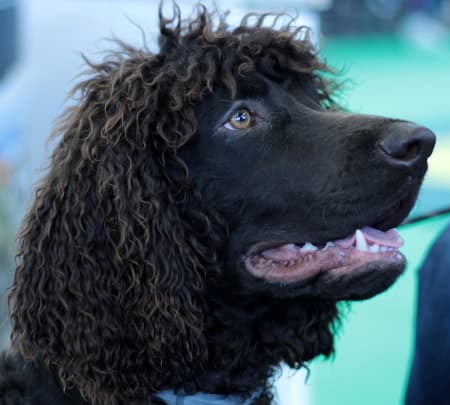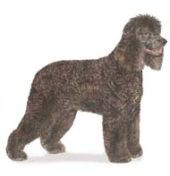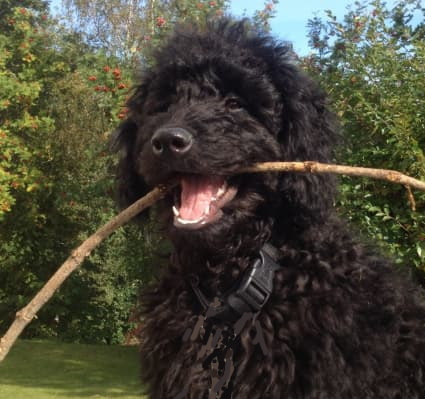Irish Water Spaniels
Intelligent, Vigorous And Fun-Loving!
Irish Water Spaniels, are thought to have originated from water dogs
that existed in ancient Persia. In fact, Persian manuscripts from 4000
BC, point to the existence of water spaniels in Ireland around that time
period.
With such ancient roots, it is understandable that the exact lineage of the breed is not clear, but it has been speculated and kind of obvious that poodles and various spaniels may have contributed to its evolution. This seems to be born out by its physical appearance.

The main job of this active spaniel is to retrieve birds over water, but he also has the ability plus the zeal to retrieve game over land.
Irish Water Spaniels, also known as the Shannon Spaniels, are the largest of the spaniels and very athletic.
The breed was first recognized by the American kennel club in 1884. Their population in the United States is quite small to the degree that they could be considered a rare breed.
The IWS is a very solid-looking, tall dog with long ears, an alert expression and a curly coat similar to that of a Poodle. His feet are webbed which assists him with swimming.
Characteristics of Irish Water Spaniels
The Irish Water Spaniel is a cheerful dog - very smart, good-natured, loyal and easy-going. Many owners enjoy being entertained by his fun-loving and clownish antics.
He is not known to be a barker, but has protective instincts around strangers and does have a commanding bark when needed.
With a high degree of intelligence, the Irish Water Spaniel trains easily and wants to please, though he can be a bit stubborn. Firm, yet fair leadership is called for with this breed, along with early socialization.
Using his strong retriever instincts in training sessions and to fetch things around the house, will be met with an enthusiastic response!
Irish Water Spaniels - Stats And Care

Height: 21-24 inches
Weight: 45-65 pounds
Color variations: Solid liver, with a purplish tint
The weather resistant double coat is dense, tight and consists of crisp ringlets over the body, sides, and neck. The legs are also covered by a mass of longer curls or waves.
Surprisingly the tail is without curls except for a small amount at the top - hence the nicknames of whip tail spaniel or rat tail dog as they are sometimes called. However, this hairless feature of the tail does enhance their swimming skills as do the webbed feet.
The Irish Water Spaniel's coat has an oily texture and needs to have significant grooming to prevent matting.
Hair cuts are best left to a professional groomer, though you can learn to do this yourself, if so inspired, as the IWS is said to be very tolerant of getting his hair done!
Shedding is minimal, putting this dog on the list of "hypoallergenic breeds", or those more suitable for owners with allergies.
Coat grooming consists of methodically brushing and combing in layers. A slicker brush with long bent pins and long-tooth buttercomb are your best tools for the job. Do this a couple of times a week to keep matts and tangles under control and have the groomer, or yourself, trim the coat every 2 to 3 months to keep its shape.

Grooming also involves taking a look inside the ears for any adverse signs and giving them a cleaning if necessary. Regular nail clipping is a must (if you hear them clicking on the floor - it's past time!) as well as cleaning the teeth daily, to avoid lots of serious problems.
Health Notes
Dogs with droopy ears, such as seen in most spaniels, do tend to be more susceptible to ear infections.
Other health issues that have been noted and may affect the breed during its lifetime include:
- Eye problems such as entropian - a disease that can lead to loss of vision if not recognized and treated.
- Hip and elbow dysplasia
A good book to have on hand is the Comprehensive Owner's Guide book to Irish Water Spaniels which can be obtained here.

What Is the Activity Level of Irish Water Spaniels?
Glad you asked, because this is important information to know if you are considering the breed.
Irish Water Spaniels are exercise machines, with great stamina and need a lot of physical activity. Since they are superb swimmers and obviously love to retrieve, water activities will be eagerly and enthusiastically welcomed as part of their routine.
Vigorous daily walks are expected. This breed is ideal for an active family and if there is a jogger around, they will happily be running companions.
Since these spaniels are very smart dogs, time spent in various training activities can help to satisfy their need for mental stimulation. In fact, they love to have jobs to do!
Ideal Living Space?
The IWS is well suited to rural residences where he can romp and run freely, but suburban homes will do if there is an adequate fenced yard. Apartment living not so much.
Outdoor space not only gives the dog another outlet for his high energy and a place for training, but also benefits owners to have a space available where their pet can happily wait for his walk.
Does the IWS Get Along With Children?
The Irish Water Spaniel is a fun companion and has a good reputation for being very friendly with children.
However, because of his size and high energy, it is my opinion that he is better suited to a family with older children who have been "seasoned" to having a large dog around.
The usual caution remains, no matter what the breed, that interaction between dogs and children should always be supervised by an adult.
Suitability For Senior or Sedentary Families?
Although affectionate, protective and loyal, the necessity for significant exercise, would usually rule out Irish Water Spaniels as not being the best choice for the seniors or sedentary families.
That being said, people are living longer these days due to advances in health care and there are lots of very active seniors who might enjoy this playful, fun companion.
And, as for the more sedentary families, they can enjoy the breed too if there is someone available to take care of the exercise.
Share Your Knowledge and Pictures
Do
you have a Irish Water Spaniel? If you do, then you know a lot about
what it's like to live with this energetic and handsome dog breed.
We would love for you to share your dog's pictures and his story as well as your knowledge about the breed in general.
You can upload photos and tell your dog's story here.
For inspiration, read some of the stories about various breeds, already submitted by other dog lovers.
Photo Resources: Sonja-Kalee

